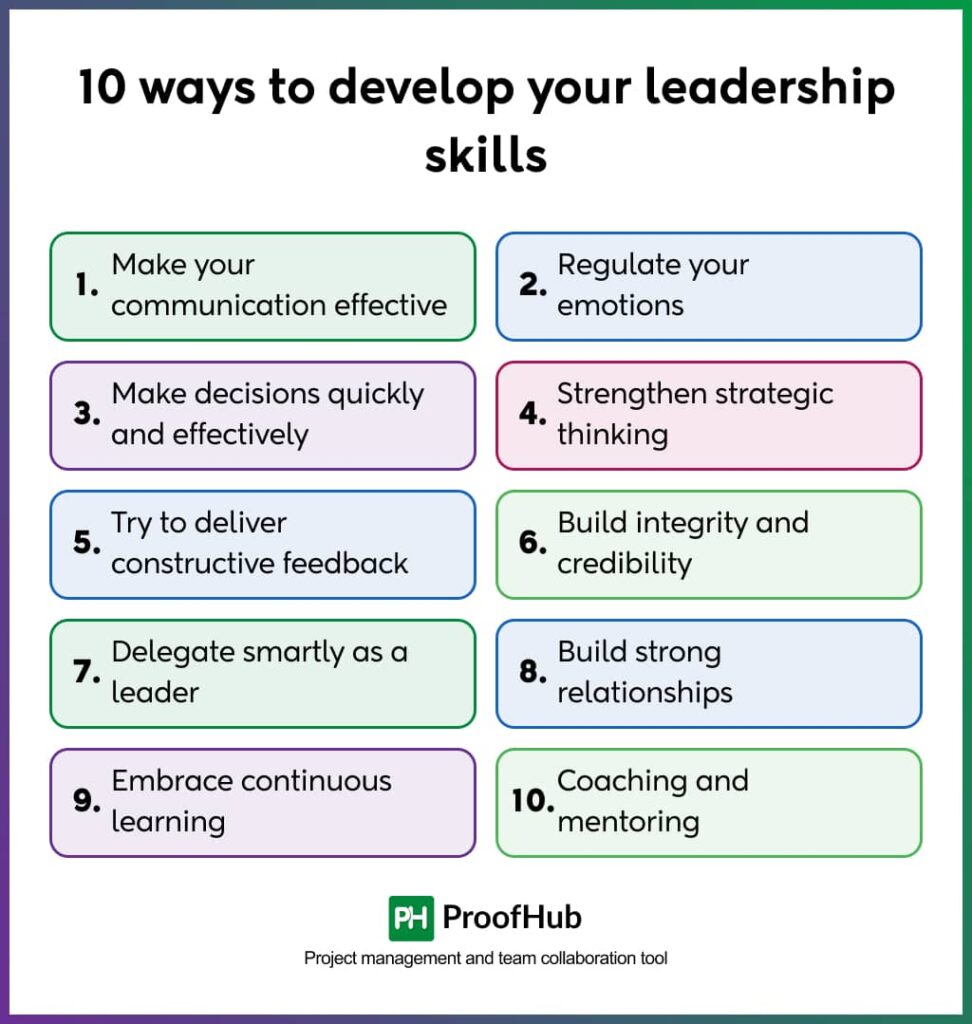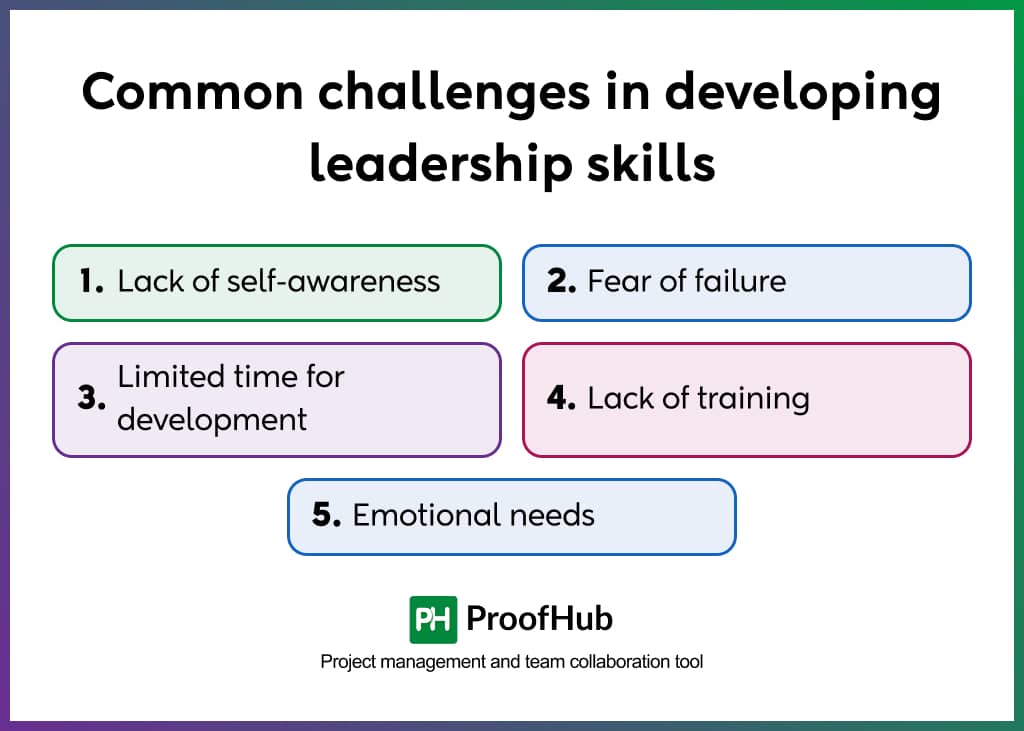through hard work.
Leadership isn’t about having a fancy title; it’s about making a profound impact. In the modern workplace, where uncertainty is constant and collaboration is crucial, strong leadership can be the difference between a team that grows and one that falls apart.
According to Wharton Work, nearly 60% of new managers never receive formal leadership training, which often leads to common struggles like unclear communication, low team morale, missed deadlines, and poor accountability. These don’t just slow progress, they bruise trust and performance.
But here’s the upside: leadership can be learned. Whether you’re stepping into a leadership role or looking to grow in the one you have, developing the right skills can transform not just your team’s outcomes, but your confidence and career.
In this blog, we’ll break down 10 practical ways to develop your leadership capabilities so you can lead with clarity, empathy, and impact.
10 ways to develop your leadership skills
When you step into a leadership role, experience doesn’t suffice. You must have a strong foundation of skills that can guide and support a team.
According to research by Gallup, a significant 70% of the variance in team engagement is directly influenced by the manager or team leader.
Hence, good leadership qualities can set you apart from the crowd and foster a productive and motivated environment to ensure long-term success.

1. Make your communication effective
Good communication is the foundation of effective leadership; it ensures clarity, fosters trust, and keeps teams aligned. When communication breaks down, confusion, misalignment, and frustration follow. On the other hand, leaders who communicate well can energize their teams, set clear expectations, and build stronger relationships.
Whether you’re discussing goals, navigating challenges, or simply checking in with your team, the best leaders listen actively, speak with clarity, and adapt their tone and message to the situation. They understand that communication isn’t just about speaking, it’s about making sure the message is understood.
How to develop it?
- Be clear and concise: Avoid jargon and long-winded explanations. Get to the point without ado, especially when sharing goals or decisions.
- Prepare before important conversations: Think through what you want to say and expect possible questions to prepare in advance.
- Pay attention to nonverbal cues: Your tone, facial expressions, and body language everything impact how your message is received.
- Listen with full attention: Eliminate distractions when someone is speaking. Active listening builds trust and helps you respond more thoughtfully.
2. Regulate your emotions
Research shows that emotionally intelligent leaders improve both behaviors and business results and have a positive impact on work-team performance.
When leaders understand and manage their emotions, they improve their ability to communicate effectively, build trust, and resolve workplace conflict easily. This particular skill can help leaders handle stress and setbacks effectively, leading to better team performance and decision-making.
Emotion regulation, resilience, and effective leadership go hand in hand. It helps leaders to clear their heads and empathize with other people. This emotional balance can allow leaders to be effective, influential, and responsible while making decisions or leading teams.
How to regulate your emotions?
- Evaluate your level of control: Before you take action on a situation, you must have control over the situation. When you determine what the situation is, if it is under control or not, you help understand what emotional responses are appropriate.
- Try to express your feelings positively: You are only human if you feel negative emotions, but the way you present those emotions is crucial for your image as a leader. When you feel negative emotions, you must focus on your breath and respond with clarity rather than reactivity.
- Prepare for conflict: You must prepare yourself to cater to every situation. It doesn’t mean you should look for a fight every time. It means you should think about how you will respond during a conflict so your brain is prepared with healthy responses and coping mechanisms.
- Take a pause: Whenever you feel agitated, angry, or hurt, don’t react at that moment. Take a while to think before responding so you can answer carefully, whether it is online or face-to-face conversations.
3. Make decisions quickly and effectively
Research shows decisive leaders reduce team stress by 40% and accelerate project completion by 30%.
Taking quick decisions doesn’t mean you need to make decisions at the moment if a situation arises; it is more concerned with making decisions without hesitation or procrastination.
When you are being decisive, you are not rushing it means you have the confidence and clarity to act promptly. What sets effective leaders apart is their ability to course-correct when needed and take accountability for their choices. By developing this skill, you create momentum, reduce delays, and model confidence for your team even during uncertain times.
How can you make prompt decisions?
- Gather information effectively: At first, you must understand the importance of the decision and what you hope to achieve. You need to seek out the facts, data, and insights to support your decision. Also, include your team to gain different viewpoints and ensure you are not missing anything.
- Set deadlines and prioritize: Give yourself a timeframe in which you have to make a decision and stick to it. Try to address the most important matters first.
- Use decision-making frameworks: There are several frameworks that must be followed by leaders before they make a decision. You can make use of a Pro/con analysis where you weigh the advantages and disadvantages, a Decision matrix where you use a matrix to evaluate options based on different criteria, and a Fishbone diagram, to break down complex problems to identify their root causes and potential solutions.
- Learn from your previous decisions: To make better decisions in the future, you need to conduct post-decision reviews where you need to analyze what has worked well and what could have been improved during the decision-making process.
4. Strengthen strategic thinking
Strategic thinking is crucial for leaders so they can make long-term plans and see the bigger picture. It helps them go through complex situations, anticipate future trends, and make informed decisions that benefit the organization.
Leadership strengths develop when leaders focus on long-term goals and align their actions with the overall vision. Strategic leaders can effectively guide their teams and achieve sustainable success. Strategic thinking isn’t just about having a plan; it’s about seeing connections others miss, identifying opportunities before they arise, and aligning daily actions with long-term outcomes.
What do you need to do?
- Develop a bigger picture perspective: You must be aware of industry updates and market movements which might impact your business. You should think about what choices will affect the organization in the future.
- Ask strategic questions: Ask questions that go beyond the surface level, dig deeper, and don’t settle for the first answer. Look at the different ways of thinking about problems and solutions. When you ask strategic questions, you can easily identify potential advantages and disadvantages.
- Embrace the growth mindset: Recognize that strategic thinking is a continuous process of learning and improvement. Get input from others and learn from their experiences. You must not be afraid to make mistakes, learn from them, and move forward.
5. Try to deliver constructive feedback
Providing constructive feedback is essential to foster growth, improve employee performance, and build a positive work environment. While providing constructive feedback, employees must be provided with specific, actionable suggestions for improvement and focus on future development rather than past mistakes.
When leaders prioritize growth and provide support, they can enhance individual as well as team performance, which leads to better results and a more engaged workforce. Constructive feedback helps in more than one way; it helps to promote growth and development, enhance communication, and boost team morale and engagement.
What do you need to do?
- Focus on behaviour: Whenever you give feedback, you need to avoid personal attacks. Try to use “I” in statements to express your feelings and observations.
- Provide actionable suggestions: Try to suggest concrete solutions to the person who can actually improve. Encourage them to try new approaches and track their progress. Along with it, set goals and provide a roadmap to achieving them.
- Maintain a supportive tone: Try to use a supportive and understanding tone even when you are delivering negative feedback. Also, acknowledge the individual strengths and good work.
- Give real-time feedback: Don’t wait for performance reviews or end-of-week check-ins. Offering feedback in real time can make it more relevant and impactful. It helps team members understand what worked, what didn’t, and how to improve while the context is still fresh in everyone’s mind.
6. Build integrity and credibility
Building integrity and credibility is essential as a leader so you can foster trust, motivate teams, and drive positive organizational outcomes. When you have integrity, you are honest and trustworthy. When you show ethical behaviour, you form a foundation for credibility. It forms a perception that you are reliable and have expertise.
To build integrity and credibility as a leader, you need to focus on consistent ethical behaviour, transparency, accountability, and reliability.
How to achieve integrity and credibility?
- Be authentic and transparent: As a leader, you need to be authentic, which involves being genuine to yourself. Being transparent means being open and honest in your communication, even when it is difficult.
- Lead by example: Leaders should inspire the team by demonstrating the behaviours and values they expect from their team. This includes ethical conduct, commitment to excellence, and a willingness to learn and grow.
- Ethical decision-making: Consider the potential impact of your decisions on others and prioritize integrity over short-term gains. Uphold ethical principles in all your interactions, even when it’s challenging.
- Accountability and responsibility: As a leader, you need to take ownership of your decisions and try to learn from them. Demonstrate accountability by accepting responsibility for your actions, even when things don’t go as planned.
7. Delegate smartly as a leader
Smart delegation is a key leadership practice which helps in assigning tasks to team members by leveraging their strengths and fostering growth. It also helps in freeing the leader’s time for strategic initiatives. It is not only concerned with assigning tasks, it is more about empowering individuals and developing their capabilities. Smart delegation is necessary so it can build trust and drive organizational success.
Delegating tasks involves the identification of tasks that are suitable for others, selecting the right individuals, and providing clear instructions and resources. If you delegate smartly, you can provide clear instructions, resources, and foster a culture of trust.
How to achieve it?
- Identify what to delegate: As a leader, you need to understand your strengths and weaknesses. Take notes of where your time is best spent and where others can contribute more effectively. Try to focus on high-leverage tasks and delegate those that don’t require your specialized expertise. Delegate those tasks that others can do at least 80% as well as you or better.
- Choose the right individuals: When you assign tasks, you need to match the skills and have an interest in the project. Try to delegate tasks that can help team members develop new skills and take on more responsibility.
- Communicate clearly: While you delegate, you need to set clear expectations, provide context and guidance to get the desired outcomes, and get the work done on time.
- Foster trust and empowerment: Trust your team by believing in their abilities and allowing them to make decisions. Try to provide autonomy to your team members by giving them the freedom to approach tasks in their way as long as they achieve the desired results.
- Monitor progress and provide support: Make sure you establish open and regular communication to address questions and provide support. As a supportive leader, you must monitor progress, provide feedback, and offer guidance.
8. Build strong relationships
Building strong relationships as a leader is crucial for fostering a positive work environment, effective leadership, and driving team success. When you establish a strong relationship with your team, you create a culture which leads to increased engagement, motivation, and productivity.
The reason why building strong leadership matters is because it helps increase engagement and motivation, improves productivity and performance, enhances creativity and innovation, better problem-solving, reduces burnout, and fosters a positive workplace culture.
How to build it?
- Focus on connection and empathy: Try to make a connection with your team by making informal communications. You can take time to know your team members on a personal level. Try to empathize and understand their problems in detail.
- Foster effective communication: Pay close attention to what others are saying, ask questions, and provide feedback. Talk clearly and make sure your messages are easy to understand and free from ambiguity.
- Build trust and respect: As a leader, you must avoid being someone else, be yourself, and acknowledge and appreciate the contributions of your team members.
9. Embrace continuous learning
Continuous learning is what keeps leaders adaptable and relevant. In a world where change is the only constant, leaders who commit to ongoing development can better navigate challenges, embrace innovation, and inspire their teams to grow as well. By staying curious and open to feedback, leaders not only sharpen their skills but also model a mindset of growth and resilience.
Great leaders don’t just accumulate knowledge, they apply it. They read, reflect, ask questions, and seek insights from both successes and setbacks. Whether it’s learning from a mentor, signing up for a leadership course, or simply pausing to assess what went well after a project, every experience becomes a classroom. This learning mindset encourages experimentation, fuels personal development, and builds teams that are more empowered, informed, and future-ready.
How to achieve it?
- Stay updated with trends: Read industry blogs, follow thought leaders, attend webinars, and join professional networks to stay informed about new developments in your field.
- Seek feedback and reflect: Make a habit of asking your team, peers, or mentors for honest feedback. Use it as a tool for growth, not criticism. Regular reflection on your decisions and actions helps you learn faster.
- Invest in development opportunities: Enroll in leadership courses, listen to podcasts, or join workshops. Even 15 minutes a day dedicated to learning can compound into powerful insights over time.
- Encourage a learning culture: Support your team’s learning efforts, too. Share resources, discuss what you’re learning, and create space for growth in your team’s day-to-day work.
10. Coaching and mentoring
One of the most powerful roles a leader can play is that of a coach or mentor. While managing focus on getting things done, coaching focuses on helping others grow. Effective leaders invest time in guiding, supporting, and developing their team members. They don’t just delegate tasks, they empower people to think critically, build confidence, and unlock their full potential. Coaching and mentoring foster stronger relationships, boost engagement, and cultivate a culture of continuous improvement.
Mentorship goes a step further by sharing your own experiences, lessons, and wisdom to accelerate someone else’s journey. When leaders commit to helping others rise, they build more capable, confident, and loyal teams.
What do you need to do?
- Schedule regular one-on-ones: Create dedicated time to connect with your team members. Use these conversations to understand their goals, challenges, and development needs, not just their to-do lists.
- Ask guiding questions: Instead of giving quick answers, ask open-ended questions that help people think through their challenges. This encourages ownership, problem-solving, and deeper learning.
- Share your experiences: Be open about your own leadership journey successes, failures, and lessons learned. Real-world context adds depth and relatability to your guidance.
- Give actionable feedback: Feedback should be specific, timely, and focused on growth. Praise what’s working, and offer constructive direction where improvement is needed.
- Encourage peer mentoring: You don’t have to be the only mentor. Foster a culture where teammates support, teach, and learn from each other to multiply growth across the team.
Common challenges in developing leadership skills
Becoming a strong leader takes more than ambition; it requires time, self-awareness, and the ability to overcome real challenges. Whether you’re new to leadership or working to reach that level, the following are some of the most common challenges that can slow your progress:

1. Lack of self-awareness
One of the most overlooked challenges is when you don’t have a clear understanding of your strengths, weaknesses, and leadership style. Many leaders operate on autopilot, unaware of how their behaviors affect others. Without honest feedback or self-reflection, your mistakes go unchecked, which often leads to poor communication and team disconnect.
2. Fear of failure
Leadership often involves making tough calls and taking risks. The fear of getting it wrong can cause hesitation, avoidance of conflict, or a tendency to micromanage. But failure is part of the process. Leaders who see mistakes as learning opportunities can build more confident teams.
3. Limited time for development
Busy schedules can make leadership development avoidable. Between meetings, emails, and daily tasks, there’s often little time left for reading, reflection, or skill-building. But without intentional effort, growth stops.
4. Lack of training
Many professionals are promoted into leadership roles without any preparation. While they may be good at their work, leading people is a completely different thing. Without proper mentoring, coaching, or training, leaders are left to rely on the trial-and-error method, which can slow progress.
5. Emotional needs
Leadership is not just strategic, it’s emotional. Managing your own mindset while supporting others through change, conflict, or stress is no small task. It requires emotional intelligence, empathy, and the ability to remain grounded during uncertainty.
Final thoughts
To put it all together, leadership is not about authority; it’s about growth, influence, and meaningful impact. When you proclaim the 10 skills mentioned in this article, you not only elevate your team’s performance but also build your confidence and greater career opportunities.
Tools like ProofHub support this journey by making it easier to communicate, delegate effectively, and provide timely feedback. By streamlining the way you manage projects and collaborate with your team, ProofHub helps you develop daily habits like clarity, accountability, and support that ultimately enhance your leadership skills.
Frequently asked questions
How long does it take to develop effective leadership skills?
Leadership is a continuous journey; the basic skills associated with it can be improved in weeks, but mastering it can take years of experience and adaptation.
How can I develop leadership skills in the workplace?
You can develop leadership skills by seeking stretch assignments, asking for feedback from your peers, observing other leaders, and practicing self-reflection.
What are the 3 C’s of leadership?
The three c’s of leadership are clarity, context, and composure.
- Clarity: Communicate goals and expectations transparently.
- Context: Align actions with the bigger picture.
- Composure: Stay calm and decisive under pressure.
What are the 5 qualities of a good leader?
The 5 qualities of a good leader are integrity, adaptability, empathy, decisiveness, and accountability.
What’s the difference between leadership and management?
The major difference between leadership and management is that management focuses on efficiency while leadership focuses on influence. The former focuses on processes, deadlines, and control, while the latter includes vision, inspiration, and empowerment.

